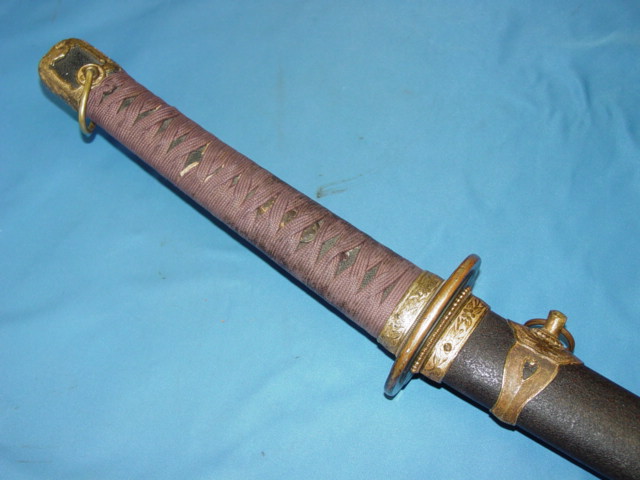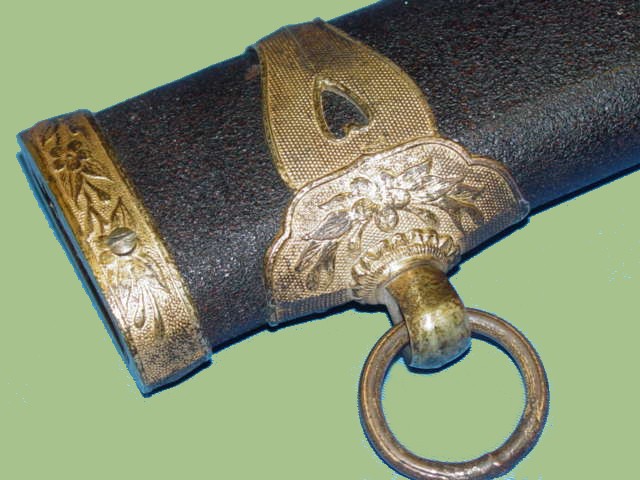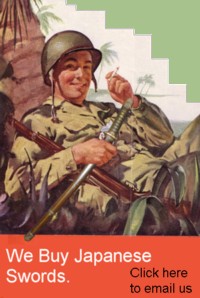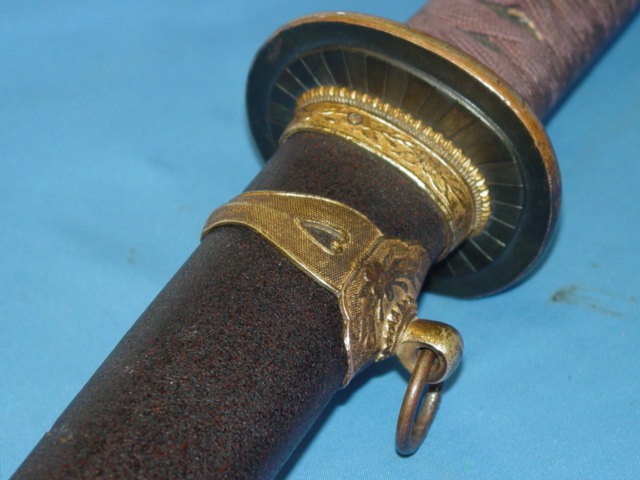SAMURAI SWORD 34 - WWII NAVAL KATANA - KUNIMORI
This is a Japanese WWII Naval Katana sword. Made by renown sword maker Kunimori. The sword is outfitted in the
traditional naval attire. It is important to note that if you have a sword that looks like this one does not mean
that it is a Kunimori sword. In order to be a Kunimori sword the signature in the tang has to match his signature.
The handle, sheath and other components are shared with thousands of other swords that were produced for the Japanese
Navy.

The handle of the sword has a metal cap that covers the pommel. A hole is drilled at the bottom of the cap to allow
the lanyard ring to pass through. Some of the rings are highly decorated. The one shown in this example is of plain
design.
The handle is wrapped with a light purpke cloth. Two Menukis are covered by the wrappings. One on each side of the
handle. They are black in color and have the three flower design.
The handle is covered with ray skin that has been dyed black. The texture is bumpy.


|
The Samurai sword has a very rich history. The sword has been manufactured for several centuries and continues
to be produced today. The sword represented more than just a weapon. It was the soul of the Samurai warrior.
When attempting to identify the type of sword you have It is important to keep in mind that the fittings of
a sword (scabbard, handle, crossguard. etc.) may be identical from one sword to another. The reason why is
because during WWII the same fittings were used in all Army swords, Navy swords, etc. Armed forces are all
about uniformity. They strive to make everything the same.
This is the reason why a sword cannot be identified merely by its external appearance.
Understanding the different components that make up the Samurai sword is the first step in figuring out the
type of sword you have. That is the reason why we have created the
Understanding the Samurai sword section as a means to
provide a novice with the basic knowledge to start the path of determining the questions everyone has;
who made the sword, how old it is nad how much it is worth.
|

The scabbard is finished in a dark color with a beautiful texture. Two ornate gold metal rings are placed near the
throat. Each band has a stud that holds a suspension ring. Navy swords came equipped with two suspension rings.


The following pictures show the locking mechanism for the sword. A high level of attention was dedicated to
the construction of this sword. To the point that even the spring has been marked with Kanji symbols. The
metal ring is placed at the base of the handle. It has a hole design to accomodate the locking release button.
The ring is nicely decorated with a leafy pattern.
The sword is automatically locked in place when it is put inside the sheath. This is a safety measure to ensure the
sword does not fall out. Depressing the button releases the lock and allows the sword to be removed.

|
This page is a recognition and identification guide for Samurai swords.
Multiple detailed photos of a specific sample are provided. Descriptions point
out clearly defined points that should be noted.
One of the most commonly asked questions is "How much is my Samurai Sword worth?".
A price guide is included here to address this question. The value of the swords is
reviewed over a period of several years. A trend can be observed. The present worth
of the edge weapons in the collector's market is illustrated.
This service is provided free of charge to the visitor/enthusiast courtesy of
MilitaryItems.com,
a company dedicated to the preservation of military history and to providing quality
military antiques and collectibles to museums, institutions and the general public.
|
|

This sword has some of the most complete markings available. As it can be seen on the photo below, even the
locking spring has been marked by the maker. Most of the times this piece is not marked at all.
Another interesting aspect is that the Habaki is made of solid Silver.



|
WE BUY JAPANESE SWORDS - All types of Japanese edge weapons. Whether it is a WWII era Samurai sword or an
older type of blade.
The process gets started by you sending us an
Email .
We will respond to your inquiry normally within 24 hours and in many cases much faster.
We can tell you what you have, what it is worth and how much we can pay you.
One sword or an entire collection -
Email Us .
|
 |



The different parts that secure the Tsuba in place are marked. In some cases arabic numbers are employed
to apply the markings. This example has Kanji (Japanese writing) markings.
After the sword is taken apart. Putting the spacers back in place can be a bit of a challenge. They may
not want to re-seat properly. Tapping the pommel with a rubber hammer can make the fittings fit
properly again.


The following photograph provides a side view of how the different washers and Tsuba are mounted on the
sword. Some of the tang markings are clearly visible through the fittings. All parts have a rectangular
hole cut to allow the locking mechanism to pass through.
One common problem when handling the sword by inexperienced individuals is that they force the blade out
without pressing the button to unlock the sword. Forcing the sword can cause damage to the lock. Sometimes
it can break. Always press the button to disengage the lock before pulling the blade out.


The sword featured here has more markings than normally seen.
One side of the tang has been marked primarily with date related information. The upper section of the inscription
refers to the 2,604th year from the foundation of the empire. It was common for the Japanese to refer to years
in terms where you had to add two numbers to come up with the proper date.

The other side of the tang includes a small saying: "I gladly give my life". Probably a refernce to the willingness
of the soldier to commit to battle until death. The next section of the signature bears the name of the maker.
What is interesting to note is that "Ikansai" was actually the middle name of the maker. However, it appears that
in this case is being used as a first name. His last name was "Kunimori".
The entire set of characters basically states that Kunimori was a resident of Tokyo and he made the sword.



By the Numbers
It is next to impossible to determine the exact number of Samurai swords that were produced and issued to
Japanese soldiers during the war. However, thanks to the record keeping maintained by the US Armed Forces,
it is possible to estimate how many swords were actually shipped home.
 |
There were over 500,000 Samurai swords were brought back home as souvenirs from the war.
There are several caviats to this number.
|
 |
For example, some soldiers took souvenirs and shipped them home circumbenting the established process.
Some of the swords were brought back inside duffle bags without anyone knowing except for the soldier who
captured the sword. This fact would clearly affect the final count.
The number also does not account for swords that were taken by Allied soldiers from other countries.
Collecting Samurai swords
Collecting Samurai swords is a field that has been growing since the days the GI's rummaged around Asia
bringing back military souvenirs. Japanese soldiers carried many of these swords when they went to
battle. Once the soldier was killed or captured, the Americans would take the edge weapons as war trophies.
Eventually all these pieces came back to the United States where military history enthusiasts began to collect them.
 |
In trying to determine if you should collect Samurai swords there are certain factors that should be
considered.
The adjacent table outlines some of the advantages and disadvantages of collecting the Samurai swords.
|
 |
This Samurai Sword may be currently reproduced.
It is becoming more difficult to be able to tell the fake ones from the real ones because
the quality of the reproductions is improving. The collector must become familiarized with
the construction style and materials employed in the manufacturing of this item.
Attention to the details is critical in order to be able to determine the authenticity of
the collectible.
If you have an interest is seeing other Japanese Samurai swords, you can do so by going to our
Japanese Samurai Swords Price Guide
identification guide. Where we cover Samurai swords from all periods.
| 




